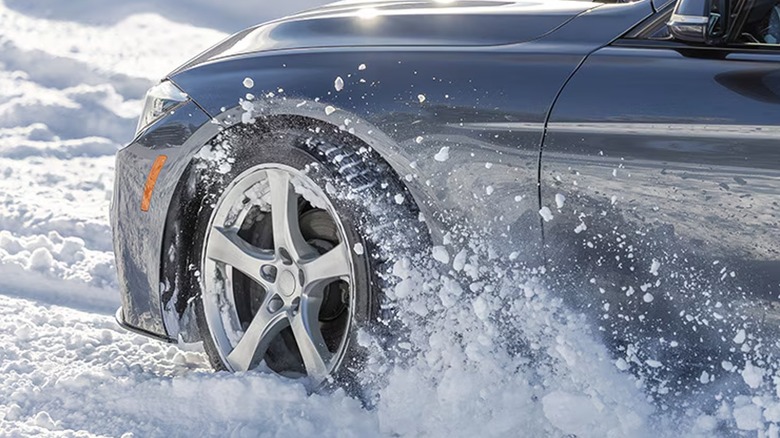What's So Special About Bridgestone Blizzak Tires And Can You Drive On Them Year-Round?
Anyone who lives in the northern parts of the United States knows that roads can get a bit dicey during the winter season. Roads freeze over, leading to the eternal scourge that is black ice, making things unsafe for anyone and everyone. Even if things don't get to that point, you still have to deal with piled-up snow keeping your tires from actually making contact with the road, as well as slushy runoff when it inevitably melts. There's a reason winter is one of the worst seasons to drive in.
When you have to be on the roads in frozen conditions, safe driving skills are paramount, but in addition to that, it wouldn't hurt to equip your vehicle with a little something extra to even the odds. Snow tires, for example, are readily available at most automotive stores to give your car a bit of extra purchase in the frozen wastes. If you happen to be within convenient distance of a Bridgestone tire store, then you've already got an attractive option available from one of the most well-regarded tire brands: Bridgestone's own Blizzak winter tires, specially designed to tackle a variety of winter driving scenarios for a wide range of cars.
Blizzak tires are specially-designed to provide ample grip on wintery roads
The point of Blizzak tires, as well as winter tires in general, is to increase the amount of grip that your tires have on the road and, in situations where the road is obscured by ice, snow, or slush, grind through it all to make contact with the pavement. In the particular case of Blizzak tires, this is accomplished through a combination of hydrophilic materials and specially designed tread and sipe patterns.
Blizzak tires are coated with Bridgestone's proprietary multicell compound, granting them a porous surface that removes water from the top layer of ice on the road. This reduces the chances of hydroplaning and ensures you always keep your traction. This process is aided by the tires' wide treads, which helps them maintain a firm grip on the road. The most interesting aspect of these tires are their dense sipes, which function kind of like a set of jagged teeth. These teeth allow your vehicle to effectively chomp down on the road, which keeps you from sliding away. All of this adds up to tires that can stop firmly on snow and ice, maintain steady handling on slushy terrain, and keep a strong grip on the road no matter what.
Blizzak tires come in seven different models, ranging in application from small sedans all the way up to light commercial trucks. No matter what you're driving, there's a Blizzak for the job.
Blizzak tires should only be driven on during the winter season
Since Blizzak tires are so great at keeping you on the road during inclement weather, you might be tempted to install them on your car and just leave them there, even after the winter season has ended. Unfortunately, as is often the case with winter tires in general, trying to use Blizzak tires outside of the winter season would be inadvisable.
Bridgestone only recommends using Blizzak tires during the winter season which, at least for the coldest northern regions of the United States, lasts from mid-October to mid-April at the most. If you live further south, then they would have a shorter period of ideal usage than that. The reason for this is that, if you were to use Blizzak tires when there are no winter obstacles on the road, you would wear out those specialized treads and sipes much faster than usual. They're meant to chomp through snow and ice, so if they're only getting a proverbial faceful of pavement, they're just going to wear away.
On the bright side, based on Bridgestone's estimates, a set of WS90 Blizzak tires should be able to safely ferry you around for about 1,200 miles per month in the winter season. Even if you're running them absolutely ragged the whole season, they should be able to last through at least two years' worth of winters, and probably longer than that if you're not doing that much driving and swap them out with all-terrains outside of winter.


